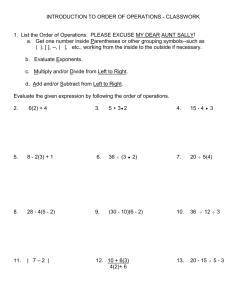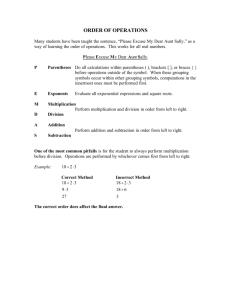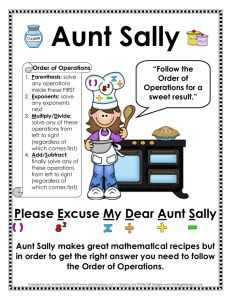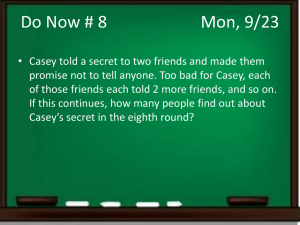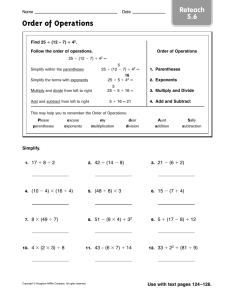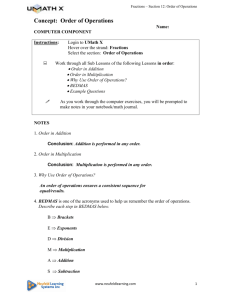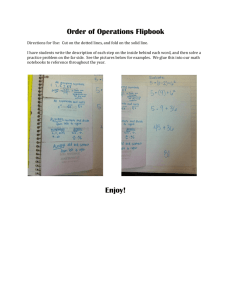Tricky Technicality for the Order of Operations rule
advertisement
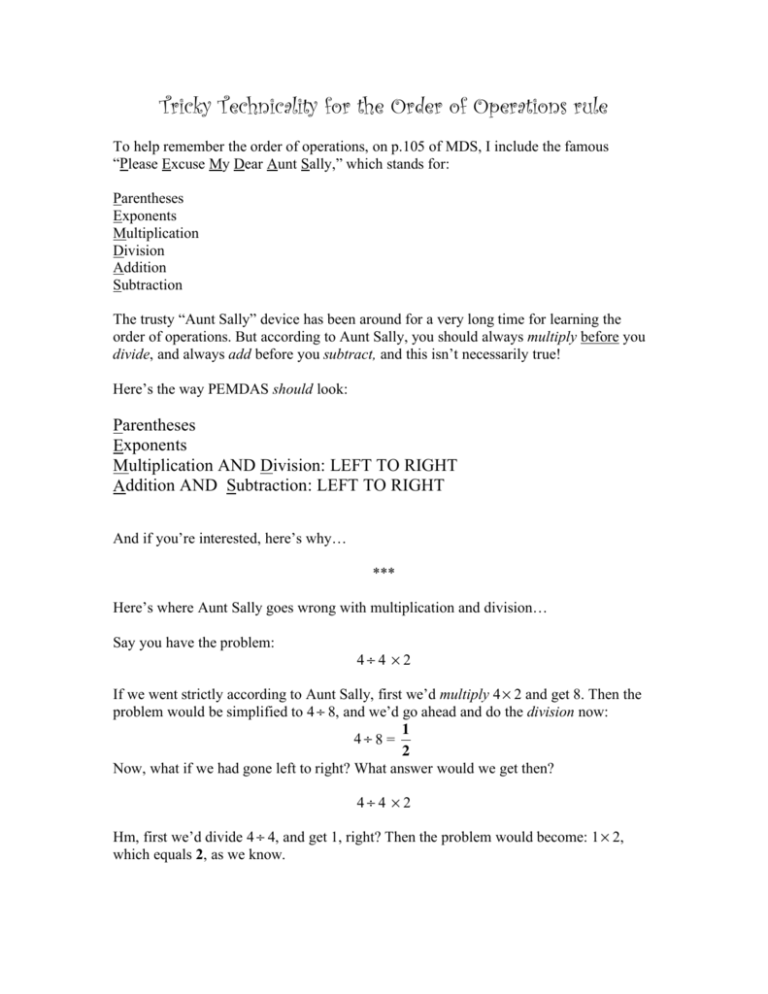
Tricky Technicality for the Order of Operations rule To help remember the order of operations, on p.105 of MDS, I include the famous “Please Excuse My Dear Aunt Sally,” which stands for: Parentheses Exponents Multiplication Division Addition Subtraction The trusty “Aunt Sally” device has been around for a very long time for learning the order of operations. But according to Aunt Sally, you should always multiply before you divide, and always add before you subtract, and this isn’t necessarily true! Here’s the way PEMDAS should look: Parentheses Exponents Multiplication AND Division: LEFT TO RIGHT Addition AND Subtraction: LEFT TO RIGHT And if you’re interested, here’s why… *** Here’s where Aunt Sally goes wrong with multiplication and division… Say you have the problem: 4÷4 2 If we went strictly according to Aunt Sally, first we’d multiply 4 2 and get 8. Then the problem would be simplified to 4 ÷ 8, and we’d go ahead and do the division now: 1 4÷8 = 2 Now, what if we had gone left to right? What answer would we get then? 4÷4 2 Hm, first we’d divide 4 ÷ 4, and get 1, right? Then the problem would become: 1 2, which equals 2, as we know. Wait! 2? OMG, which one is the correct answer? 1 or 2? 2 Hm…I’m going to show you something by writing the problem a little differently. After all, as we get more into Algebra, fraction notation gets used much more often for 4 division than the actual “ ÷ ” symbol. And if we replaced “4 ÷ 4” by “ ” for the division, 4 our problem would look like this, right? 4 2 4 And now, no matter what order we start to simplify it in, we’ll always get the answer 2, 4 which by the way, happens to be the correct answer. We could first simplify = 1, and 4 then the problem would be simplified down to: 1 2, which equals 2. Or if we first 4 42 8 = = 2. See? We get the same both multiplied the times the 2, we’d get: 4 4 4 ways, so long as fraction notation is used instead of the division symbol, “ ÷ ”. *** Now let me show you a quick example of the Addition/Subtraction issue: Say you have the simple problem: 6–1+2 You should do the subtraction first, because it comes first, LEFT TO RIGHT. So you’d subtract 6 – 1 and now your problem looks like: 5 + 2, which you’d add to get 7. This is the right answer. However, if you did the addition first (the way dear Aunt Sally would have you believe), you’d first add the 1 + 2, get 3, and then subtract it from the 6 to get the wrong answer of 3. Once you get into Algebra, you’ll find that you’ll begin to think of subtraction as “adding negative numbers.” So you’d look at this problem like this: 6 + (-1) + 2 And now, no matter what order you do things in, because the negative sign is “stuck” to only the 1, and can’t affect the 2 at all. Again, for the record, the more accurate “Aunt Sally” rule would state this order: Parentheses Exponents Multiplication AND Division: LEFT TO RIGHT Addition AND Subtraction: LEFT TO RIGHT The great news is, once you get well into Algebra, you’ll see that the issue simply isn’t an issue – you’ll start to think about subtracting as “adding negative numbers” and the fraction notation takes care of the division problem completely, so there won’t be anything to worry about! Just keep an eye out when you see the division symbol “ ÷ ” in a long string of operations, be sure to do your mult/div in order, LEFT to RIGHT, and do your add/sub in order, LEFT to RIGHT, and you’ll be in great shape!
